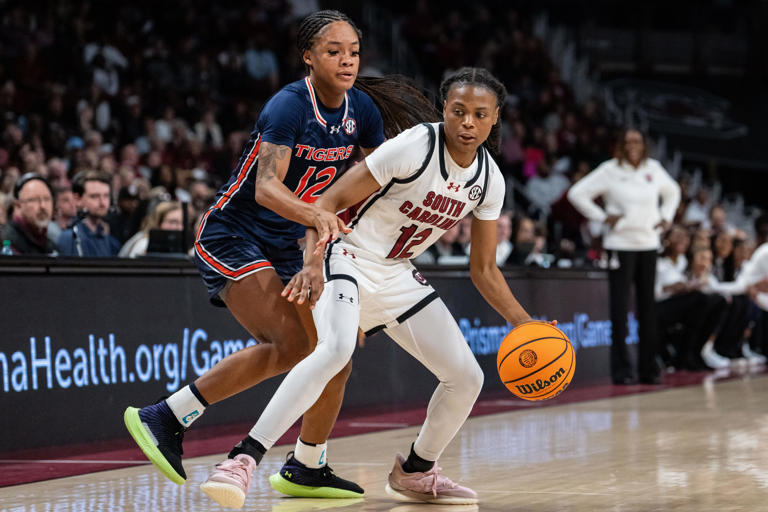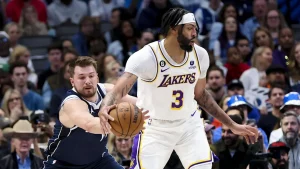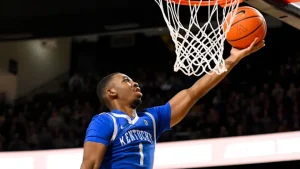
South Carolina’s victory over Auburn in their latest SEC matchup highlighted the resilience and tactical brilliance of both coach Dawn Staley and her players in maintaining an undefeated conference record. Facing Auburn’s notorious, relentless defense, which is one of the toughest in the SEC, the Gamecocks found themselves in a challenging position, but ultimately triumphed due to their ability to adapt and execute. This victory not only solidified their dominance in the SEC but also showcased the depth of their team and the tactical adaptability of Dawn Staley.
Auburn’s Relentless Defense
Auburn’s defensive strategy is designed to disrupt their opponents’ rhythm, forcing turnovers, and creating fast-break opportunities. Their aggressive full-court press, quick rotations, and suffocating on-ball defense are designed to wear down teams physically and mentally. Against a team as potent as South Carolina, Auburn’s defense was tasked with containing star players while forcing others to step up in moments of adversity.
Auburn’s defensive scheme is a classic example of pressuring teams from the get-go. They apply a full-court press that disrupts opposing offenses right from the inbound pass. Once the ball crosses half-court, Auburn switches to a suffocating half-court defense that seeks to eliminate any easy shots and push the opposing offense into unfavorable situations.
For South Carolina, a team used to controlling the tempo and dictating the pace of the game, Auburn’s defense posed a significant challenge. South Carolina’s offense is predicated on quick ball movement, high basketball IQ, and their powerful inside game led by players like Aliyah Boston, but Auburn’s strategy aimed to dismantle these strengths by forcing turnovers and closing down passing lanes.
Dawn Staley’s Tactical Adjustments
South Carolina’s head coach, Dawn Staley, is renowned for her ability to make in-game adjustments that allow her team to succeed under pressure. She was well aware of Auburn’s defensive prowess and had prepared her team accordingly. The key to breaking Auburn’s defense lay in staying poised, maintaining discipline, and making smart decisions with the ball.
1. Speed and Ball Movement
One of the first adjustments Staley made was speeding up the offense. Auburn thrives when it can control the tempo and dictate how teams move the ball. South Carolina countered this by not allowing the Tigers’ defense to set up as easily. They employed quick ball movement, which made it harder for Auburn to anticipate passes and close down shooting lanes. The Gamecocks ran fast breaks to push Auburn’s defense back before it could fully set up in the half-court. This tempo-based offense, focused on pushing the ball ahead as soon as a rebound or steal was made, negated some of the pressure Auburn aimed to apply.
2. Spacing the Floor
Another critical aspect of Staley’s strategy was ensuring her team spaced the floor effectively. By stretching Auburn’s defense horizontally, South Carolina opened up more opportunities for both inside and outside scoring. Aliyah Boston, who is both a dominant post player and a capable passer, was crucial in this regard. By moving her off the block at times and setting high screens, Staley created options for both Boston and her teammates to make quick decisions. This not only disrupted Auburn’s defensive rotations but also gave players like Zia Cooke and Brea Beal more room to maneuver.
3. Pick-and-Roll Plays
Recognizing the pressure Auburn’s defense placed on individual ball handlers, Staley’s Gamecocks used pick-and-roll plays effectively. These sets allowed players like Cooke and Beal to operate with a screen, which freed them up for better scoring opportunities or quick passes to open teammates. By setting multiple screens and forcing Auburn’s defenders to switch, South Carolina was able to create mismatches. On some occasions, this resulted in easy baskets at the rim, while on others, it led to open jump shots.
Player Adjustments
While Staley’s coaching was pivotal, the individual efforts of South Carolina’s players were crucial in breaking Auburn’s defense. Several key players stepped up in this game, countering Auburn’s relentless pressure with poise and confidence.
1. Aliyah Boston’s Inside Dominance
As the centerpiece of South Carolina’s offense, Aliyah Boston was a key player in breaking Auburn’s defense. Despite facing double-teams and aggressive post defense, Boston’s skill in the low post and her ability to finish through contact kept the defense honest. Auburn struggled to keep Boston off the glass, and her presence in the paint opened up opportunities for her teammates to knock down outside shots. Boston’s rebounding was also vital; it gave South Carolina second-chance opportunities, which allowed them to maintain offensive possessions even when their first options didn’t succeed.
2. Zia Cooke’s Scoring Prowess
Zia Cooke, another one of the Gamecocks’ star players, demonstrated her ability to score in a variety of ways. Auburn’s defense made it difficult for Cooke to find clean looks, but she was able to adapt by driving to the basket, getting fouled, and hitting free throws when the defense overcommitted. Cooke’s quickness and ability to attack the rim became essential, particularly in breaking through Auburn’s perimeter defense. Her ability to hit contested mid-range shots and three-pointers also allowed South Carolina to stretch Auburn’s defense, preventing them from focusing solely on the inside game.
3. Brea Beal’s Defensive Impact and Offense
While Beal is known for her defensive prowess, in this game, she also showcased her growth as a scorer. Beal’s ability to finish around the rim and hit mid-range jumpers helped balance South Carolina’s offensive attack. Her defense, however, was equally important. She took on the challenge of guarding Auburn’s best perimeter players, helping to stifle Auburn’s attempts to push the pace and get easy scoring opportunities off turnovers.
Auburn’s Adjustments and Counterattack
Despite their best efforts, Auburn could not maintain their defensive pressure for an entire game. South Carolina’s adjustments slowly chipped away at the Tigers’ strategy, and their offense became more efficient as the game progressed.
Auburn tried to adjust by switching between man-to-man and zone defenses. The zone defense was meant to clog the paint and prevent easy inside points, but it allowed South Carolina to exploit the perimeter more effectively. South Carolina hit timely three-pointers, especially from players like Cooke and Beal, forcing Auburn to adjust back to man defense, which only allowed more space for Boston to dominate inside.
Auburn also made efforts to control the tempo by slowing the game down in the half-court, but South Carolina’s fast-break game proved to be too much for the Tigers. When Auburn did get out in transition, South Carolina’s defense was well-positioned to limit easy baskets. The Gamecocks’ defense is one of the best in the nation, and their ability to contain Auburn’s offensive threats kept the pressure squarely on the Tigers.





